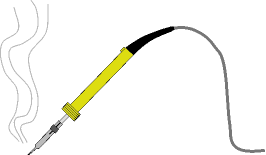Home |
Capacitor |
Connector |
Diode |
IC |
Lamp |
LED |
Relay |
Resistor |
Switch |
Transistor |
Variable Resistor |
Other

74 Series Logic ICs
HC & HCT families | LS family | Open collector outputs
Gates: 2-input | 3-input |
4-input | 8-input | NOT
Decade and 4-bit counters: 7490 | 7493 | 74390 |
74393 | 74160-3 | 74192-3 |
74HC4017
12-bit and 14-bit counters: 74HC4020 | 74HC4040 |
74HC4060
Decoders & display drivers: 7442 | 7447 |
74HC4511
Also see: 4000 Series | Logic Gates |
Counting Circuits |
ICs (chips) (with summary of logic ICs)
General characteristics
There are several families of logic chips numbered from 74xx00 onwards with letters (xx) in the middle of the number
to indicate the type of circuitry, eg 74LS00 and 74HC00. The original family (now obsolete) had no letters, eg 7400.
The 74LS (Low-power Schottky) family (like the original) uses TTL (Transistor-Transistor Logic) circuitry
which is fast but requires more power than later families. The 74 series is often still called the 'TTL series'
even though the latest chips do not use TTL!
The 74HC family has High-speed CMOS circuitry, combining the speed of TTL with the very low power
consumption of the 4000 series. They are CMOS chips with the same pin arrangements as the older 74LS family.
Note that 74HC inputs cannot be reliably driven by 74LS outputs because the voltage ranges used for logic 0
are not quite compatible, use 74HCT instead.
The 74HCT family is a special version of 74HC with 74LS TTL-compatible inputs so 74HCT can be
safely mixed with 74LS in the same system. In fact 74HCT can be used as low-power direct replacements for
the older 74LS ICs in most circuits. The minor disadvantage of 74HCT is a lower immunity to noise, but
this is unlikely to be a problem in most situations.
The CMOS circuitry used in the 74HC and 74HCT series ICs means that they are
static sensitive.
Touching a pin while charged with static electricity (from your clothes for example) may
damage the IC. In fact most ICs in regular use are quite tolerant and earthing your hands
by touching a metal water pipe or window frame before handling them will be adequate.
ICs should be left in their protective packaging until you are ready to use them.
To compare the different logic families please see the Summary table of logic families
For most new projects the 74HC family is the best choice.
The 74LS and 74HCT families require a 5V supply so they are not convenient for battery operation.
74HC and 74HCT family characteristics:
- 74HC Supply: 2 to 6V, small fluctuations are tolerated.
- 74HCT Supply: 5V ±0.5V, a regulated supply is best.
- Inputs have very high impedance (resistance), this is good because it means
they will not affect the part of the circuit where they are connected. However, it
also means that unconnected inputs can easily pick up electrical noise and rapidly
change between high and low states in an unpredictable way. This is likely to make
the chip behave erratically and it will significantly increase the supply current.
To prevent problems all unused inputs MUST be connected to the
supply (either +Vs or 0V), this applies even if that part of the chip is
not being used in the circuit!
Note that 74HC inputs cannot be reliably driven by 74LS outputs because the
voltage ranges used for logic 0 are not quite compatible. For reliability use
74HCT if the system includes some 74LS chips.
- Outputs can sink and source about 4mA
if you wish to maintain the correct output voltage to drive logic inputs, but
if there is no need to drive any inputs the maximum current is about 20mA.
To switch larger currents you can
connect a transistor.
- Fan-out: one output can drive many inputs (50+), except 74LS inputs because
these require a higher current and only 10 can be driven.
- Gate propagation time: about 10ns for a signal to travel through a gate.
- Frequency: up to 25MHz.
- Power consumption (of the chip itself) is very low, a few µW.
It is much greater at high frequencies, a few mW at 1MHz for example.
74LS family TTL characteristics:
- Supply: 5V ±0.25V, it must be very smooth, a regulated supply is best.
In addition to the normal supply smoothing, a 0.1µF capacitor should
be connected across the supply near the chip to remove the 'spikes' generated
as it switches state, one capacitor is needed for every 4 chips.
- Inputs 'float' high to logic 1 if unconnected, but do not rely on this in a
permanent (soldered) circuit because the inputs may pick up electrical noise.
1mA must be drawn out to hold inputs at logic 0. In a permanent circuit it is wise
to connect any unused inputs to +Vs to ensure good immunity to noise.
- Outputs can sink up to 16mA (enough to light
an LED), but they can source only about 2mA.
To switch larger currents you can
connect a transistor.
- Fan-out: one output can drive up to 10 74LS inputs, but many more 74HCT inputs.
- Gate propagation time: about 10ns for a signal to travel through a gate.
- Frequency: up to about 35MHz (under the right conditions).
- Power consumption (of the chip itself) is a few mW.
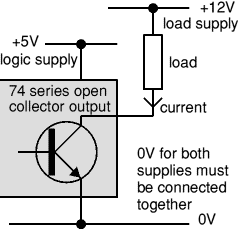
Open Collector Outputs
Some 74 series ICs have open collector outputs, this means they can sink
current but they cannot source current. They behave like an NPN
transistor switch.
The diagram shows how an open collector output can be connected to sink current from a supply which has a
higher voltage than the logic IC supply. The maximum load supply is 15V for most open collector ICs.
Open collector outputs can be safely connected together to switch on a load when any one of them is low;
unlike normal outputs which must be combined using diodes.
There are many ICs in the 74 series and this page only covers a selection,
concentrating on the most useful gates, counters,
decoders and display drivers.
For each IC there is a diagram showing the pin arrangement and brief notes explain
the function of the pins where necessary.
For simplicity the family letters after the 74 are omitted in the diagrams below
because the pin connections apply to all 74 series gates with the same number.
For example 7400 NAND gates are available as 74HC00, 74HCT00 and 74LS00.
If you are using another reference please be aware that there is some variation in
the terms used to describe pin functions, for example reset is also called clear.
Some inputs are 'active low' which means they perform their function when low.
If you see a line drawn above a label it means it is active low, for example:
 (say 'reset-bar').
(say 'reset-bar').
Datasheets are available from:
Gates
Quad 2-input gates
- 7400 quad 2-input NAND
- 7403 quad 2-input NAND with open collector outputs
- 7408 quad 2-input AND
- 7409 quad 2-input AND with open collector outputs
- 7432 quad 2-input OR
- 7486 quad 2-input EX-OR
- 74132 quad 2-input NAND with Schmitt trigger inputs
The 74132 has Schmitt trigger inputs to provide good noise immunity.
They are ideal for slowly changing or noisy signals.
- 7402 quad 2-input NOR
Note the unusual gate layout.
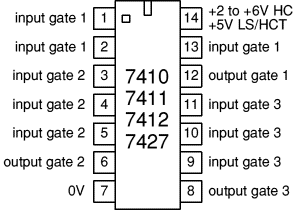
Triple 3-input gates
- 7410 triple 3-input NAND
- 7411 triple 3-input AND
- 7412 triple 3-input NAND with open collector outputs
- 7427 triple 3-input NOR
Notice how gate 1 is spread across the two sides of the package.
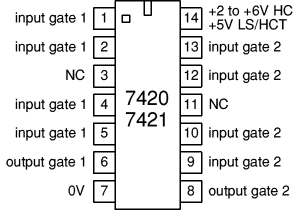
Dual 4-input gates
- 7420 dual 4-input NAND
- 7421 dual 4-input AND
NC = No Connection (a pin that is not used).
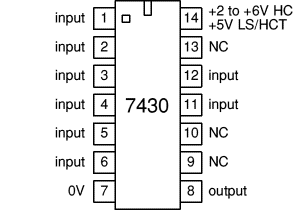
7430 8-input NAND gate
NC = No Connection (a pin that is not used).
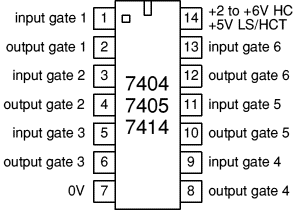
Hex NOT gates
- 7404 hex NOT
- 7405 hex NOT with open collector outputs
- 7414 hex NOT with Schmitt trigger inputs
The 7414 has Schmitt trigger inputs to provide good noise immunity.
They are ideal for slowly changing or noisy signals.
Counters
7490 decade (0-9) ripple counter
7493 4-bit (0-15) ripple counter
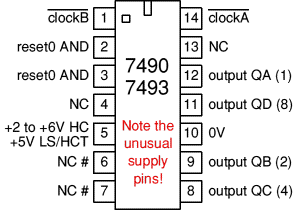 |
NC = No Connection (a pin that is not used).
# on the 7490 pins 6 and 7 connect to an
internal AND gate for resetting to 9.
For normal use connect QA to clockB and
connect the external clock signal to clockA.
|
These are ripple counters so beware that glitches may occur in any logic gate systems connected
to their outputs due to the slight delay before the later counter outputs respond to a clock pulse.
The count advances as the clock input becomes low (on the falling-edge), this is indicated
by the bar over the clock label. This is the usual clock behaviour of ripple counters and it means
a counter output can directly drive the clock input of the next counter in a chain.
The counter is in two sections: clockA-QA and clockB-QB-QC-QD. For normal use connect QA to clockB to link
the two sections, and connect the external clock signal to clockA.
For normal operation at least one reset0 input should be low, making both high resets the counter to zero
(0000, QA-QD low). Note that the 7490 has a pair of reset9 inputs on pins 6 and 7, these reset the counter to
nine (1001) so at least one of them must be low for counting to occur.
Counting to less than the maximum (9 or 15) can be achieved by connecting the appropriate output(s) to
the two reset0 inputs. If only one reset input is required the two inputs can be connected together.
For example: to count 0 to 8 connect QA (1) and QD (8) to the reset inputs.
Connecting ripple counters in a chain: please see 74393 below.
74390 dual decade (0-9) ripple counter
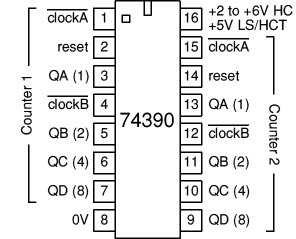 |
For normal use connect QA to clockB and
connect the external clock signal to clockA. |
The 74390 contains two separate decade (0 to 9) counters, one on each side of the chip.
They are ripple counters so beware that glitches may occur in any logic gate systems connected to
their outputs due to the slight delay before the later counter outputs respond to a clock pulse.
The count advances as the clock input becomes low (on the falling-edge), this is indicated
by the bar over the clock label. This is the usual clock behaviour of ripple counters and it means
a counter output can directly drive the clock input of the next counter in a chain.
Each counter is in two sections: clockA-QA and clockB-QB-QC-QD. For normal use connect QA to clockB to link
the two sections, and connect the external clock signal to clockA.
For normal operation the reset input should be low, making it high resets the counter to zero
(0000, QA-QD low).
Counting to less than 9 can be achieved by connecting the appropriate output(s) to the reset input,
using an AND gate if necessary. For example: to count 0 to 7 connect QD (8) to reset, to count 0 to 8 connect
QA (1) and QD (8) to reset using an AND gate.
Connecting ripple counters in a chain: please see 74393 below.
74393 dual 4-bit (0-15) ripple counter
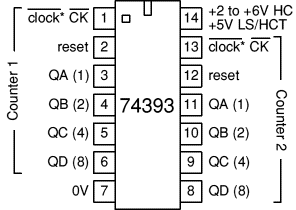 The 74393 contains two separate 4-bit (0 to 15) counters, one on each side of the chip.
They are ripple counters so beware that glitches may occur in logic systems connected to
their outputs due to the slight delay before the later outputs respond to a clock pulse.
The 74393 contains two separate 4-bit (0 to 15) counters, one on each side of the chip.
They are ripple counters so beware that glitches may occur in logic systems connected to
their outputs due to the slight delay before the later outputs respond to a clock pulse.
The count advances as the clock input becomes low (on the falling-edge), this is indicated
by the bar over the clock label. This is the usual clock behaviour of ripple counters and it means
means a counter output can directly drive the clock input of the next counter in a chain.
For normal operation the reset input should be low, making it high resets the counter to zero
(0000, QA-QD low).
Counting to less than 15 can be achieved by connecting the appropriate output(s) to the reset input,
using an AND gate if necessary. For example to count 0 to 8 connect QA (1) and QD (8) to reset using an AND gate.
Connecting ripple counters in a chain
The diagram below shows how to link ripple counters in a chain, notice how the highest output QD of each
counter drives the clock input of the next counter.

74160-3 synchronous counters
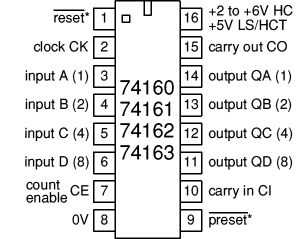 |
* reset and preset are both active-low
preset is also known as parallel enable (PE)
|
- 74160 synchronous decade counter (standard reset)
- 74161 synchronous 4-bit counter (standard reset)
- 74162 synchronous decade counter (synchronous reset)
- 74163 synchronous 4-bit counter (synchronous reset)
These are synchronous counters so their outputs change precisely together on each clock pulse.
This is helpful if you need to connect their outputs to logic gates because it avoids the glitches which
occur with ripple counters.
The count advances as the clock input becomes high (on the rising-edge).
The decade counters count from 0 to 9 (0000 to 1001 in binary).
The 4-bit counters count from 0 to 15 (0000 to 1111 in binary).
For normal operation (counting) the reset, preset, count enable and carry in
inputs should all be high. When count enable is low the clock input is ignored and counting stops.
The counter may be preset by placing the desired binary number on the inputs A-D, making
the preset input low, and applying a positive pulse to the clock input.
The inputs A-D may be left unconnected if not required.
The reset input is active-low so it should be high (+Vs) for normal operation (counting).
When low it resets the count to zero (0000, QA-QD low), this happens immediately with the
74160 and 74161 (standard reset), but with the 74162 and 74163 (synchronous reset)
the reset occurs on the rising-edge of the clock input.
Counting to less than the maximum (15 or 9) can be achieved by connecting the appropriate output(s)
through a NOT or NAND gate to the reset input.
For the 74162 and 74163 (synchronous reset) you must use the output(s) representing one less
than the reset count you require, e.g. to reset on 7 (counting 0 to 6) use QB (2) and QC (4).
Connecting synchronous counters in a chain
The diagram below shows how to link synchronous counters such as 74160-3, notice how all the
clock (CK) inputs are linked. Carry out (CO) is used to feed the carry in (CI)
of the next counter. Carry in (CI) of the first 74160-3 counter should be high.

74192 up/down decade (0-9) counter
74193 up/down 4-bit (0-15) counter
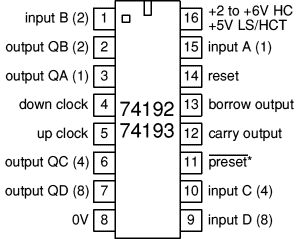 |
* preset is active-low
|
These are synchronous counters so their outputs change precisely together on each clock pulse.
This is helpful if you need to connect their outputs to logic gates because it avoids the glitches which
occur with ripple counters.
These counters have separate clock inputs for counting up and down.
The count increases as the up clock input becomes high (on the rising-edge).
The count decreases as the down clock input becomes high (on the rising-edge).
In both cases the other clock input should be high.
For normal operation (counting) the preset input should be high and the reset input low.
When the reset input is high it resets the count to zero (0000, QA-QD low)
The counter may be preset by placing the desired binary number on the inputs A-D and briefly
making the preset input low. Note that a clock pulse is not required to preset, unlike the 74160-3 counters.
The inputs A-D may be left unconnected if not required.
Connecting counters with separate up and down clock inputs in a chain
The diagram below shows how to link 74192-3 up/down counters with separate up and down clock inputs,
notice how carry and borrow are connected to the up clock and down clock
inputs respectively of the next counter.

74HC4017 decade counter (1-of-10)
74HC4020 14-bit ripple counter
74HC4040 12-bit ripple counter
74HC4060 14-bit ripple counter with internal oscillator
These are the 74HC equivalents of 4000 series CMOS counters.
Like all 74HC ICs they need a power supply of 2 to 6V.
For pin connections and functions please see: 4017 | 4020 |
4040 | 4060
Decoders
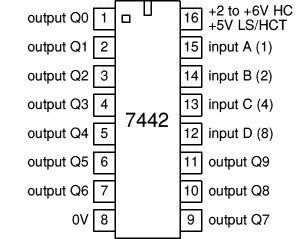
7442 BCD to decimal (1 of 10) decoder
The 7442 outputs are active-low which means they become low when selected but are high
at other times. They can sink up to about 20mA.
The appropriate output becomes low in response to the BCD (binary coded decimal) input.
For example an input of binary 0101 (=5) will make output Q5 low and all other outputs high.
The 7442 is a BCD (binary coded decimal) decoder intended for input values 0 to 9 (0000 to 1001
in binary). With inputs from 10 to 15 (1010 to 1111 in binary) all outputs are high.
Note that the 7442 can be used as a 1-of-8 decoder if input D is held low.
Also see: 74HC4017 and 4017
both are a decade counter and 1-of-10 decoder in a single IC.
7-segment Display Drivers
7447 BCD to 7-segment display driver
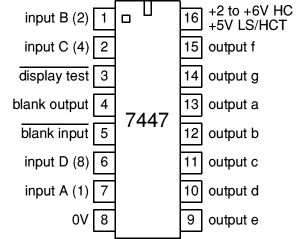 The appropriate outputs a-g become low to display the BCD (binary coded decimal) number supplied
on inputs A-D. The 7447 has open collector outputs a-g which can
sink up to 40mA.
The 7-segment display segments must be connected between +Vs and the outputs with a resistor in series
(330
The appropriate outputs a-g become low to display the BCD (binary coded decimal) number supplied
on inputs A-D. The 7447 has open collector outputs a-g which can
sink up to 40mA.
The 7-segment display segments must be connected between +Vs and the outputs with a resistor in series
(330 with a 5V supply).
A common anode display is required.
with a 5V supply).
A common anode display is required.
Display test and blank input are active-low so they should be high for normal operation.
When display test is low all the display segments should light (showing number 8).
If the blank input is low the display will be blank when the count input is zero (0000).
This can be used to blank leading zeros when there are several display digits driven by a chain of counters.
To achieve this blank output should be connected to blank input of the next
display down the chain (the next most significant digit).
The 7447 is intended for BCD (binary coded decimal) which is input values 0 to 9 (0000 to 1001 in binary).
Inputs from 10 to 15 (1010 to 1111 in binary) will light odd display segments but will do no harm.
74HC4511 BCD to 7-segment display driver
This is the 74HC equivalent of the CMOS 4511 display driver. Like all 74HC ICs it needs a power supply of 2 to 6V.
For pin connections and functions please see 4511.
Home |
Capacitor |
Connector |
Diode |
IC |
Lamp |
LED |
Relay |
Resistor |
Switch |
Transistor |
Variable Resistor |
Other
© VCampus 2013, The Electronics Club,
vcampus.co


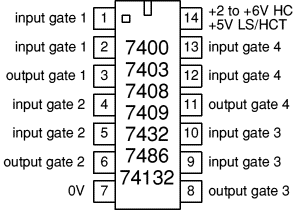
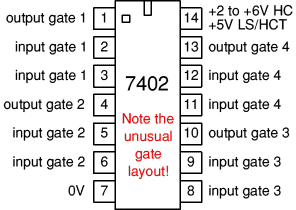






 The 74393 contains two separate 4-bit (0 to 15) counters, one on each side of the chip.
They are ripple counters so beware that glitches may occur in logic systems connected to
their outputs due to the slight delay before the later outputs respond to a clock pulse.
The 74393 contains two separate 4-bit (0 to 15) counters, one on each side of the chip.
They are ripple counters so beware that glitches may occur in logic systems connected to
their outputs due to the slight delay before the later outputs respond to a clock pulse.






 The appropriate outputs a-g become low to display the BCD (binary coded decimal) number supplied
on inputs A-D. The 7447 has open collector outputs a-g which can
sink up to 40mA.
The 7-segment display segments must be connected between +Vs and the outputs with a resistor in series
(330
The appropriate outputs a-g become low to display the BCD (binary coded decimal) number supplied
on inputs A-D. The 7447 has open collector outputs a-g which can
sink up to 40mA.
The 7-segment display segments must be connected between +Vs and the outputs with a resistor in series
(330